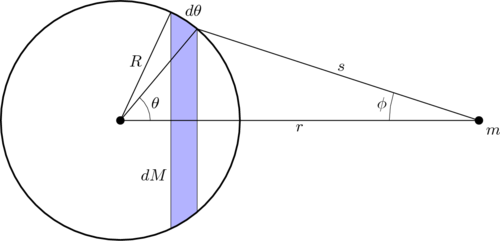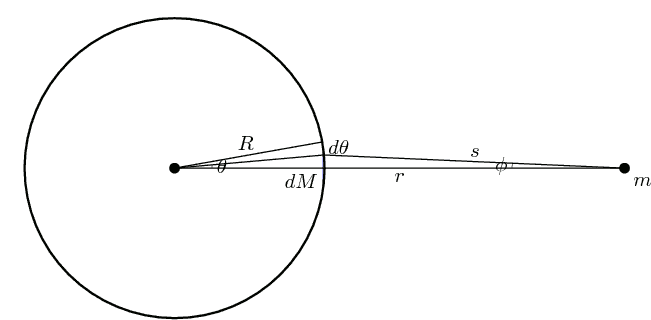Talk:Shell theorem: Difference between revisions
→Inside a Shell: new section |
|||
| Line 110: | Line 110: | ||
== Inside a Shell == |
== Inside a Shell == |
||
Not sure if it is done erroneously or blatantly but there is a difference between “force on the particle” and “force between the particles”. The net force on the point mass at exact center of the shell (empty) is zero but it will remain there forever because of balanced gravity. Here in this case F=GMm/r^2=infinity, because the on center of the shell mass and the point mass coincides, r=0. [[Special:Contributions/96.52.178.55|96.52.178.55]] ([[User talk:96.52.178.55|talk]]) 22:06, 15 June 2009 (UTC) Khattak |
Not sure if it is done erroneously or blatantly but there is a difference between “force on the particle” and “force between the particles”. The net force on the point mass at exact center of the shell (empty) is zero but it will remain there forever because of balanced gravity. Here in this case F=GMm/r^2=infinity, because the on center distance of the shell mass and the point mass coincides,i.e. r=0. [[Special:Contributions/96.52.178.55|96.52.178.55]] ([[User talk:96.52.178.55|talk]]) 22:06, 15 June 2009 (UTC) Khattak |
||
Revision as of 03:09, 16 June 2009
| Physics Start‑class Mid‑importance | ||||||||||
| ||||||||||
Is this an approxmation???
In the very first part of this article, it says that the distance from a band to the test mass in s, seen here:

Am I missing something, or is this distance along the band to the test mass variable? There is not one distance between the two but rather an infinite amount of different distances. One may be seen at the end where the slab touches the circle's perimeter, another distance may be seen where the radius, r, and the slab intersect. If it is extended into 3 dimensions, then you get even more points were s is variable. This approximation would only be valid if the test mass were extremely far away from the sphere.
Am I correct? If not, what am I missing?
Is this true ?
This just seems wrong, especially the extension to all uniform spheres. Certainly there is still gravity down a deep mine shaft within the Earth's sphere. Is there any evidence this is actually correct ? If so, how is the discrepancy with observations explained ? StuRat 04:21, 10 March 2006 (UTC)
- Of course there's still gravity down a mine shaft, because the Earth is a solid sphere, not a hollow spherical shell. —Keenan Pepper 04:48, 10 March 2006 (UTC)
- That isn't what the article says: "By extension, the same can be said of a spherically symmetric object (and all relatively large celestial bodies are spherically symmetric to a good approximation)." Hence my question. StuRat 08:32, 10 March 2006 (UTC)
- That is also true. If the Earth had a hole in its center and was spherically symmetrical, then the Earth's gravity inside the hole would be zero. A mine shaft breaks the spherical symmetry. —Keenan Pepper 13:26, 10 March 2006 (UTC)
- Sorry, but that's just nonsense. The mine shaft can't possibly change the gravitational force from zero to 9.81 m/s^2, there just isn't enough mass there. That would be saying a 10 km deep 5 meter wide cylinder of rock would generate a gravitational attraction of 9.81 m/s^2 at one end. It won't, but might be on the order of 0.01 m/s^2 . StuRat 18:07, 10 March 2006 (UTC)
- You've lost me. The mine shaft obviously doesn't change the gravitation force that much, but if the entire interior of the Earth were removed, making it spherically symmetrical, it would have a much greater effect. —Keenan Pepper 21:03, 10 March 2006 (UTC)
- The old version seemed to be saying that there is no gravity anywhere inside a solid sphere. That was wrong, only the exact center of a solid sphere has no gravity. I've since corrected the article, so it's no longer an issue. StuRat 21:15, 10 March 2006 (UTC)
- I clarified/corrected the text. "Inside the shell" is ambiguous.--Patrick 14:09, 10 March 2006 (UTC)
- Thanks for the effort. I went ahead and added sections, expanding it to all 3 logical cases (infinitely thin spherical shell, thick spherical shell, and solid sphere) and removed the stub tag. StuRat 18:32, 10 March 2006 (UTC)
Thick spherical shells
Just want to make sure my statement that "the gravitational attraction force varies linearly from 0% at the inner shell boundary to 100% (for the mass of the given sphere) at the out shell boundary" is correct. Do you guys agree ? StuRat 02:10, 11 March 2006 (UTC)
- Not linearly. It depends on the density, and even if the density is uniform, it's a cubic function, not linear. —Keenan Pepper 03:51, 11 March 2006 (UTC)
- OK, I added that to the article, which is really starting to look like something now. It now says it's a cubic function inside the wall of a thick, uniform density spherical shell and a linear function inside a uniform density solid sphere. Thanks, guys, for helping me expand this stub into an article. StuRat 20:17, 11 March 2006 (UTC)
- It's cubic for a solid sphere too. —Keenan Pepper 21:03, 11 March 2006 (UTC)
- Hmm, Patrick put that part in, so you two apparently disagree on that. I think that the article should say it's either linear or cubic, so please put that back in, when you two decide which it is. StuRat 06:45, 12 March 2006 (UTC)
According to my calculations, you're both wrong. :) Within a symmetric sphere of uniform density, gravity does indeed go linearly with distance from the center. But within a thick shell, it's neither linear nor cubic. It's asymptotic to a line at large , but as one approaches the inner empty area the curve diverges from a line; it drops off more quickly. I've got a full derivation up now. — Xaonon (Talk) 12:00, 23 April 2006 (UTC)
- Thanks for sorting that out, and improving the article so much. —Keenan Pepper 18:37, 23 April 2006 (UTC)
Third part of "By the law of cosines,"
Sin(θ)dθ = (s/rR)ds seems to have nothing to do with the law of cosines... or I'm missing something. could someone explain it to me?
also, is ds the rate of change of s? Because I get lost when it becomes part of the notation for the integration later in the page... though I suppose that the rate of change of s per s is 1...
- The law of cosines says for a triangle with sides , and an angle opposite , the following relationship holds:
- In this case we have a triangle with sides , with angles opposite respectively. Therefore,
- giving as a function of . Differentiating both sides with respect to :
- is the infinitesimal increase in that happens as a result of the infinitesimal increase in . starts at a minimum when and increases until it reaches a maximum at (although for convenience's sake we're actually integrating with respect to instead). From min to max the integration looks kind of like this:
- is the distance from to each little bit of mass in the shell at a given value of ; the sum total of all those little bits form a circle like a latitude line on the surface of the shell, which I'm calling . It may not be immediately obvious, but is always strictly increasing along the interval , even when is inside the shell. — Xaonon (Talk) 10:32, 29 October 2006 (UTC)
Starting point
Maybe I'm missing something but to me the startng point of this proof is not obvious. I do not see where the first line
comes from. To me it does not seem to be something easily seen from the diagram. Is it possible to state how this is derived?
Pagarus 08:45, 14 November 2006 (UTC)
- The shaded band is circularly symmetric about the line , so the radial components of the force on from each little bit of the band will cancel themselves out. Only the component will be nonzero, and that's of the whole force. — Xaonon (Talk) 21:12, 15 November 2006 (UTC)
Less of the arcane; more of the legible
I believe that this article can be made much better if we give it a rewrite to increase the audience capable of comprehending it. I'm pretty sure that the high math content in the article drives off more people than it helps, so increasing the amount of plain English should help. BioTube 03:26, 5 January 2007 (UTC)
I am going to try to work on this a bit. I really like the animated gif on this talk page, so I'm going to put it in the main article to help demonstrate the integration. PROBLEM THOUGH: I think that the part that is labeled d is misleading. The infinitesimal change in angle is indeed d, but the diagram seems to imply that the tiny arclength is also d, when it is actually Rd. Can anyone fix these images??
Inside a solid shell
From the article: The factors [X] and [Y] are simply the mass M of each thick shell. Thus the first two cases reduce to Newton's law of universal gravitation.
Should be: The factor [X] is simply the mass M of the shell. Thus the first case reduce to Newton's law of universal gravitation. The second case shows that inside the shell the gravitational force varies linearly from R_b to R_a. At r=R_b we have the surface gravity consistent with the Newton’s law of universal gravitation. The gravitational force tends to zero linearly as we travel from the surface toward the center of the sphere with the zero value at r<=R_a.--Zaquaraya
Is it as simple as this?
Look, am I missing something here, or is this quite a simple idea that has been endlessly complicated. Is this on the right track? Imagine a hollow, heat-proof sphere at the very centre of the Earth, and a man in that sphere. Now imagine that the Earth is uniformly dense. Gravity is pulling on that man from all sides equally, therefore all gravitation attraction is cancelled out, and the man floats weightlessly in his little sphere. There can be no other logical alternative. I remember working that out when I was 10 without recourse to Newton. Yeah, sure, give us the math, but please be so good as to state the concept to be discussed initially and with a minimum of jargon and handwaving. Myles325a (talk) 03:36, 27 November 2008 (UTC)
- It also works anywhere inside the shell. You can be ten miles north of center and you'll still be floating there, not falling in any direction —Preceding unsigned comment added by 24.162.159.61 (talk) 04:34, 4 February 2009 (UTC)
Inside a Shell
Not sure if it is done erroneously or blatantly but there is a difference between “force on the particle” and “force between the particles”. The net force on the point mass at exact center of the shell (empty) is zero but it will remain there forever because of balanced gravity. Here in this case F=GMm/r^2=infinity, because the on center distance of the shell mass and the point mass coincides,i.e. r=0. 96.52.178.55 (talk) 22:06, 15 June 2009 (UTC) Khattak























![{\displaystyle \theta =[0,\pi ]}](https://wikimedia.org/api/rest_v1/media/math/render/svg/cec515edb94fd1ec4460f84aaeed9e88d5db40ff)



